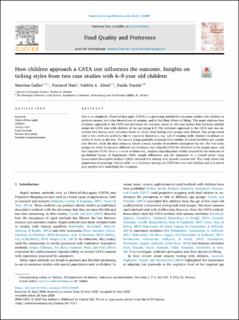| dc.contributor.author | Galler, Martina | |
| dc.contributor.author | Næs, Tormod | |
| dc.contributor.author | L. Almli, Valérie | |
| dc.contributor.author | Varela, Paula | |
| dc.date.accessioned | 2020-11-11T10:04:17Z | |
| dc.date.available | 2020-11-11T10:04:17Z | |
| dc.date.created | 2020-07-03T10:11:54Z | |
| dc.date.issued | 2020 | |
| dc.identifier.citation | Food Quality and Preference, Volume 86, December 2020, 104009 | en_US |
| dc.identifier.issn | 0950-3293 | |
| dc.identifier.uri | https://hdl.handle.net/11250/2687312 | |
| dc.description.abstract | Due to its simplicity, Check-all-that-apply (CATA) is a promising method for consumer studies with children to generate sensory and other descriptions of samples, and to find their drivers of liking. This paper explores how children’s approach to the CATA test influences the outcome, based on two case studies that illustrate suitable setups for CATA tests with children of the age group 6-9. The children's approach to the CATA task was described with ticking style indicators based on which three ticking style groups were defined. One group ticked only a few attributes probably due to cognitive limitations, e.g. lack of reading skills, limited vocabulary or ability to focus on the task. The second group gradually increased their number of ticked attributes per sample over the test, while the third subgroup ticked a steady number of attributes throughout the test. The two latter groups are likely to represent different test strategies: one using the CATA list relatively to the sample space, and one using the CATA list as in a more absolute way. Analysis regarding data validity assessed by the detection of pre-defined Design of Experiment (DoE) sample differences and the alignment to a trained panel using Quantitative Descriptive Analysis (QDA) revealed that ticking style played a crucial role. This study shows the importance of analysing “ticking style” as a validation strategy for CATA tests run with children and as a tool to gain insights into underlying test strategies. | en_US |
| dc.language.iso | eng | en_US |
| dc.rights | Attribution-NonCommercial-NoDerivatives 4.0 Internasjonal | * |
| dc.rights.uri | http://creativecommons.org/licenses/by-nc-nd/4.0/deed.no | * |
| dc.subject | Temporal Check All That Apply | en_US |
| dc.subject | Temporal Check All That Apply | en_US |
| dc.subject | Ticking style | en_US |
| dc.subject | Ticking style | en_US |
| dc.subject | Barn | en_US |
| dc.subject | Children | en_US |
| dc.title | How children approach a CATA test influences the outcome. Insights on ticking styles from two case studies with 6–9-year old children | en_US |
| dc.type | Peer reviewed | en_US |
| dc.type | Journal article | en_US |
| dc.description.version | publishedVersion | en_US |
| dc.source.volume | 86 | en_US |
| dc.source.journal | Food Quality and Preference | en_US |
| dc.identifier.doi | 10.1016/j.foodqual.2020.104009 | |
| dc.identifier.cristin | 1818376 | |
| dc.relation.project | Nofima AS: 12047 | en_US |
| dc.relation.project | Norges forskningsråd: 262308 | en_US |
| dc.relation.project | Nofima AS: 201702 | en_US |
| dc.source.articlenumber | 104009 | en_US |
| cristin.ispublished | true | |
| cristin.fulltext | original | |
| cristin.qualitycode | 1 | |

